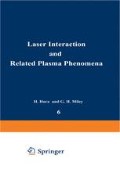Abstract
High power laser beams interact with targets by a variety of thermal, impulse and electrical effects. The laser heated plasma causes surface ablation by thermal evaporation, ion sputtering, and unipolar arcing. While the first two are purely thermal and mechanical effects, the last one, unipolar arcing, is an electrical plasma-surface interaction process which leads to crater formation, usually called laser-pitting, a process which was often observed but not well understood.
Unipolar arcing occurs when a hot plasma of sufficiently high electron temperature interacts with a conducting wall. Without an external voltage applied, many electrical micro-arcs burn between the surface and the plasma driven by local variations of the sheath potential with the wall acting as both the cathode and anode. Laser induced unipolar arcing represents the most damaging and non-uniform plasma-surface interaction process since the energy available in the plasma concentrates towards the cathode spots. This causes cratering of the materials surface. The ejection of material in the form of small jets from the craters may lead to ripples in the critical density contour. This in turn may contribute to the onset of plasma instabilities, small scale magnetic field generation and laser beam filamentation. The ejection of a plasma jet from the unipolar arc crater also causes highly localized shock waves to propagate into the target, softening it in the process. Thus, local surface erosion by unipolar arcing is much more severe than for uniform energy deposition.
Access this chapter
Tax calculation will be finalised at checkout
Purchases are for personal use only
Preview
Unable to display preview. Download preview PDF.
References
G. M. McCracken, J. Nucl. Mater. 93/94, 3(1980)
R. E. Clausing, L. C. Emerson and L. E. Heatherly, J. Nucl. Mater. 93/94, 150(1980)
G. M. McCracken and D. H. J. Goodall, Nucl. Fusion 18, 537(1978)
S. A. Cohen, H. F. Dylla, S. M. Rossnagel, S. T. Picraux and C. W. Magee, J. Nucl. Mater. 76/77, 459(1978)
P. Staib and G. Staudeimaier, J. Nucl. Mater. 76/77, 78(1978)
A. E. Robson and P. C. Thonemann, Proc. Phys. Soc. 73, 508(1959)
G. Ecker, Beitr. Plasmaphysik 11, 405(1971)
G. Ecker, IEEE Trans. Plasma Science PS-4, 218(1976)
A. E. Robson and R. Hancox, Proc. IEE, Suppl. No. 2, 47(1959)
G. H. Miley, J. Nucl. Mater. 63, 331(1976)
F. Schwirzke, L. Oren, S. Talmadge and R. J. Taylor, Phys. Rev. Letters 40, 1181(1978)
L. Oren, R. J. Taylor and F. Schwirzke, J. Nucl. Mater. 76/77, 412(1978)
G. V. Gierke, W. Ott and F. Schwirzke, Proc. Fifth International Conf. on Ionization Phenomena in Gases, Munich 1961, p. 1412
F. Schwirzke and R. J. Taylor, J. Nucl. Mater. 93/94,780(1980)
F. Schwirzke, M. H. Beelby and H. G. Ulrich, “Basic Mechanisms that Lead to Laser Target Damage”, Naval Postgraduate School Report NPS-61–82-002(1981)
O. Willi, P. T. Rumsby and Z. Q. Liu, “Laser Beam and Plasma Instabilities in the Corona of Laser Heated Targets”, Sixth International Workshop on Laser Interaction and Related Plasma Phenomena, October 25–29, 1982, Monterey, California, Volume 6, Plenum Press
F. Schwirzke, “Measurements of Spontaneous Magnetic Fields in Laser-Produced Plasmas”, Laser Interaction and Related Plasma Phenomena, Volume 3,213, Plenum Press (1974)
Author information
Authors and Affiliations
Editor information
Editors and Affiliations
Rights and permissions
Copyright information
© 1984 Plenum Press, New York
About this chapter
Cite this chapter
Schwirzke, F. (1984). Laser Induced Unipolar Arcing. In: Hora, H., Miley, G.H. (eds) Laser Interaction and Related Plasma Phenomena. Springer, Boston, MA. https://doi.org/10.1007/978-1-4615-7332-6_22
Download citation
DOI: https://doi.org/10.1007/978-1-4615-7332-6_22
Publisher Name: Springer, Boston, MA
Print ISBN: 978-1-4615-7334-0
Online ISBN: 978-1-4615-7332-6
eBook Packages: Springer Book Archive

